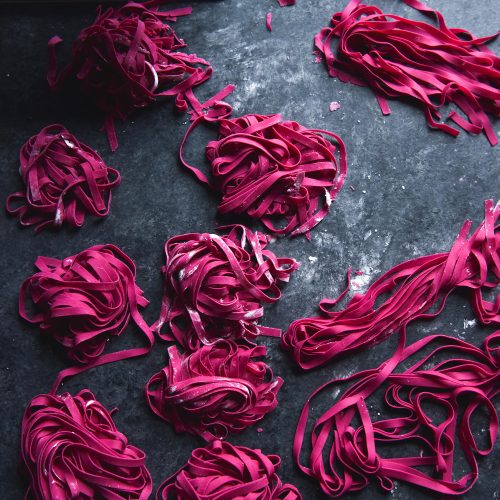
Gluten-free beetroot egg pasta
Gluten free, nut free, FODMAP friendlyAll cup measurements are in Australian cups
Ingredients
- 50-100 g roasted beetroot see notes
- 3 extra large eggs
- 60 g (1/2 cup) tapioca flour
- 240g g (1 1/4 cups) brown rice flour
- 1 teaspoon xanthan gum
- water only as necessary
- extra tapioca or brown rice flour for rolling out the pasta
Instructions
- Preheat the oven to 180C or 365F. Note that you can cook the beetroot in the oven while other dishes are cooking too. Rinse, dry and trim 1-2 small beetroots, leaving the skin on. 1 small equates to roughly 50g cooked, and 2 equates to 100g. Very lightly rub them with olive oil and cover in alfoil. Place them on a tray in the oven for about an hour or until a knife slides through easily.
- Set the beetroots aside to cool. When cool, use a paring knife to peel off the skin and chop into small-ish cubes. Add the beetroot and the eggs to a high speed food processor, and blend until completely combined and a vibrant red.
- Combine the flours and xanthan gum in a large mixing bowl. You can also do this on the table (as is traditional) but I always get excited and under-form my flour well. Also, beetroot has a tendency to stain. Either way, form a well in the flour and add in the eggs and beetroot mixture. Use a spoon and then your hands to mix the dough together.
- If you’ve been squeezing and kneading for a while and you’re absolutely convinced the dough will not form a ball, add a teaspoon of water at a time until it does. It is a dry dough, so you only need just enough liquid to bring it into a semi smooth ball. Don’t be lazy, it will make your life hard later on.
- Once you have brought the dough together into a relatively smooth ball, tear off a piece and cover the remaining pasta in cling film or a slightly dampened tea towel.
- Lightly flour the bench with tapioca flour, using as much as necessary, whenever necessary.
- Use your rolling pin to roll the piece of dough thin enough to get through the thickest setting of your pasta machine. After getting it through the thickest setting (mine is a 7) fold it and run it through the machine again. Continue rolling it through on decreased width settings until it’s thin enough for your tastes, noting that it swells during cooking (so go a little thinner than you think). I like to get mine through smoothly at setting 2 or 3 on my Jamie Oliver machine.
- I don’t have a special technique – I keep running the pasta through until it’s smooth and (ideally) has relatively straight edges. You won’t toughen the pasta from rolling, so you can re-roll as often as you see fit. If it’s wonky, you can start fresh. You can also add extra water to very dry pieces that have toughened from being rolled out.
- Once the sheet of pasta is thin enough, put it through the fettuccine cutter. I find angel hair becomes a little gloopy with this dough as it's so thin. Arrange into a little loose nest (dusting with flour if necessary) and set aside.
- Repeat with the remaining pasta dough until you have used it all. From here, you can either cook immediately, refrigerate overnight as nests, or freeze as nests. I find it tastes best fresh, but they’re all delicious regardless.
- To cook, bring a large pot of very well salted water to the boil. Add the pasta and use tongs to gently but thoroughly separate the strands. This is particularly important if you made them the night before, as they have the tendency to stick together. Cook the pasta for 2-3 minutes, until it’s lightly chewy but cooked through. If in doubt, pull it out – the high starch content can make for gloopy pasta if you cook it too long. Slightly undercooked is best (and the eggs will be fully cooked regardless!)
- Leftovers keep well in the fridge for a day or two and can be frozen. The pasta might be a little fragile after cooking and freezing, so I recommend either freezing it raw or using it up within a few days.
Tried this recipe?Let us know how it was!